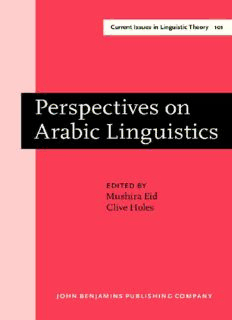
Perspectives on Arabic Linguistics: Papers from the Annual Symposium on Arabic Linguistics. Volume V: Ann Arbor, Michigan 1991 PDF
Preview Perspectives on Arabic Linguistics: Papers from the Annual Symposium on Arabic Linguistics. Volume V: Ann Arbor, Michigan 1991
PERSPECTIVES ON ARABIC LINGUISTICS V AMSTERDAM STUDIES IN THE THEORY AND HISTORY OF LINGUISTIC SCIENCE General Editor E.F. KONRAD KOERNER (University of Ottawa) Series IV - CURRENT ISSUES IN LINGUISTIC THEORY Advisory Editorial Board Henning Andersen (Los Angeles); Raimo Anttila (Los Angeles) Thomas V. Gamkrelidze (Tbilisi); John E. Joseph (College Park, Md.) Hans-Heinrich Lieb (Berlin); Ernst Pulgram (Ann Arbor, Mich.) E. Wyn Roberts (Vancouver, B.C.); Danny Steinberg (Tokyo) Volume 101 Mushira Eid and Clive Holes (eds) Perspectives on Arabic Linguistics V PERSPECTIVES ON ARABIC LINGUISTICS V PAPERS FROM THE FIFTH ANNUAL SYMPOSIUM ON ARABIC LINGUISTICS Edited by MUSHIRA EID University of Utah Salt Lake City CLIVE HOLES University of Cambridge England JOHN BENJAMINS PUBLISHING COMPANY AMSTERDAM/PHILADELPHIA 1993 Library of Congress Catalog Serial Number: 91-641663 ISBN 90 272 3603 8 (Eur.)/l-55619-554-0 (US) © Copyright 1993 - John Benjamins B.V. No part of this book may be reproduced in any form, by print, photoprint, microfilm, or any other means, without written permission from the publisher. Table of Contents Foreword vii Introduction 1 I. VARIATION IN ARABIC The Uses of Variation: A Study of the Political Speeches of Gamal Abd al-Nasir 13 Clive Holes Knowing Standard Arabic: Testing Egyptians' MSA Abilities 47 Dilworth Parkinson Stability and Language Variation in Arabic: Cairene and Kuwaiti Dialects 75 Alaa Elgibali The Meaning of Deflected/Strict Agreement Variation in Cairene Arabic 97 R. Kirk Belnap Emphasis Spread in Two Arabic Dialects 119 Munther Younes II. PHONOLOGICAL PERSPECTIVES Arabic Pharyngealization and Phonological Features 149 Stuart Davis Gemination and Antigemination in Iraqi 163 Basim Majdi & Millicent Winston vi TABLE OF CONTENTS III. SYNTACTIC PERSPECTIVES Arabic Genitives: A Problematic Structure for the Binding Theory 195 Tamar Kaplan The Copula in Modern Standard Arabic (SA) 209 Maher Bahloul The Position of Subjects in Modern Standard Arabic 231 Bernadette Plunkett Case-Marking and Binding of Subject Clitics in Arabic Complement Clauses 261 Mark S. LeTourneau IV. HISTORICAL PERSPECTIVES On the Development of the Energic Suffixes 293 David Testen Early Arabic siin and Siin in Light of the Proto-Semitic Fricative-lateral Hypothesis 313 Henry Churchyard Index of Subjects 343 FOREWORD On March 1-2, 1991, the Fifth Annual Symposium on Arabic Linguistics was held at The University of Michigan, Ann Arbor. The symposium was sponsored by the Arabic Linguistic Society, The University of Michigan's Center for Near Eastern and North African Studies and Linguistics Program, and the University of Utah's College of Humanities, Department of Languages and Literature, and Linguistics Program. A total of 20 papers were presented at the symposium; of these, 11 are published in this volume. The papers presented at the symposium were selected on the basis of an anonymous review of abstracts submitted to the Program Committee. The papers included in the volume were further reviewed by the editors before their final acceptance for publication. Two papers included in this volume (Kaplan, Davis) were presented a year later at the Sixth Symposium on Arabic Linguistics (1992). They were included here because of their relevance to other papers in the volume. The transcription of all Arabic materials in the body of the papers follows the International Phonetic Alphabet, or standard equivalents. The Arabic emphatics, however, are represented by a dot underneath the symbol, and long vowels as sequences of two vowels. The transliteration of Arabic titles in the bibliographies follows accepted formats, with some simplification in the use of diacritics. We have used ' and ' for hamza (glottal stop) and 'ayn (pharyngeal approximant), respectively. In quoted materials we followed the original text. The preparation and printing of the final manuscript was done using facilities available at the University of Utah, Salt Lake City. We would like to acknowledge the editorial assistance and computer expertise of Tessa Hauglid whose patience and diligence is particularly appreciated. INTRODUCTION Mushira Eid Clive Holes A wide variety of topics are dealt with in the section on Variation in Arabic: the function of Modern Standard Arabic (MSA) vs. dialect variation in political speeches, patterns of variation in concord in Cairene dialect, the extent to which Cairenes of different educational backgrounds can be said to 'know' MSA, and the scope of emphaticization in different Arabic dialects. In a study of a selection of political speeches made by the late president of Egypt, Gamal Abd al-Nasir, during the period 1956-65, Clive Holes shows how codeswitching between levels—from fully inflected MSA, to uninflected MSA, to a relaxed Cairene vernacular— corresponds closely to differences in the ideational content and the interpersonal context in terms of which Abd al-Nasir chose to explain the political issues of the moment. When Abd al-Nasir treats political issues from an abstract, depersonalized perspective, the language tends toward syntactic as well as lexical and phonological formality; when exactly the same or similar issues are treated in a more concrete fashion, and particularly where there are narratives, or where anecdotal material or personal experiences are detailed, there is a marked switch to the vocabulary, syntax and rhythms of everyday Cairene speech. Often, these contrasting styles are used in tandem in the same speech. Partly, this is to ensure comprehension by various potential audiences with different levels of familiarity with MSA and Cairene colloquial (both within and outside Egypt), but partly also, at the symbolic level, to create a 'man-of-the-people' image by breaking the normal 'rules of use' in a situation in which fornai language, however imperfectly understood by the audience, is normally de
Description: